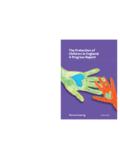Transcription of STRUCTURED DISPUTING OF IRRATIONAL BELIEFS
1 STRUCTURED DISPUTING OF IRRATIONAL BELIEFS Windy Dryden Goldsmiths University of London --------------------------------- Correspondence should be addressed to: Windy Dryden , PACE, Goldsmiths College, New Cross, London SE14 6NW, England. Email: This article was first published in: Neenan, M., & Dryden, W. (1999). Rational emotive behaviour therapy: Advances in theory and practice. London: Whurr (out of print) 1 Until recently, there has been little written in the non textbook REBT literature on DISPUTING IRRATIONAL BELIEFS . This is surprising since DISPUTING is such a central part of the REBT process. The notable exceptions to this neglect are DiGiuseppe's (1991) important chapter where he broke down DISPUTING into its component parts and Beal et al's (1996) article applying DiGiuesppe's schema to a single IRRATIONAL belief . DiGiuseppe's (1991) Contribution DiGiuseppe (1991) and his students listened too many of Albert Ellis s therapy tapes and focused on his DISPUTING work with his clients.
2 Their purpose was to develop a comprehensive taxonomy of the different elements of DISPUTING . This taxonomy described the following elements: i) The target of the dispute Disputes can be directed at the following targets: demands, awfulising BELIEFS , low frustration tolerance BELIEFS and depreciation BELIEFS (where self, others and life conditions are being depreciated). An important point stressed by DiGiuseppe is that helping clients to construct rational BELIEFS is an integral part of the DISPUTING process. In doing so, DiGiuseppe argues that it is important to use the same DISPUTING questions targeted at the alternative rational BELIEFS . Here the targets of the dispute are preferences, anti-awfulising BELIEFS , high frustration tolerance BELIEFS and acceptance BELIEFS (where self, others and life conditions are being accepted). ii) The nature of the dispute DiGiuseppe argued that disputes fall into one of three categories.
3 First, there are empirical disputes which ask clients to put forward evidence attesting to the truth or falsity of the belief . Second, there are logical disputes which ask clients to consider whether the target belief is logical or not. Third, there are heuristic disputes which ask clients to consider the functionality of the target belief . As argued above these different disputes are targeted at both IRRATIONAL BELIEFS and newly constructed rational BELIEFS . As is well accepted in REBT, IRRATIONAL BELIEFS are inconsistent with reality, illogical and yield dysfunctional 2results while rational BELIEFS are consistent with reality, logical and yield functional results. iii) Level of abstraction Both IRRATIONAL BELIEFS and rational BELIEFS can be placed along a specificity-abstractness continuum. DiGiuseppe provides an example where a client was angry at his wife for not behaving as he thinks she "should".
4 And shows that this client could have several BELIEFS ranging from the very specific: "My wife must make dinner when I want her to make it" to the very abstract: "The world must be the way I want it". It follows that disputes can be directed at BELIEFS that range along this continuum. Therapists can make two major errors here. First, they can direct their disputes at BELIEFS that are too abstract and second, they can fail to help their clients to dispute core IRRATIONAL BELIEFS by DISPUTING only very concrete IRRATIONAL BELIEFS . DISPUTING Styles DiGiuseppe (1991) identified four major DISPUTING styles. These are i) Socratic DISPUTING . Here therapists dispute their clients' IRRATIONAL BELIEFS and help them to test out their newly constructed rational BELIEFS by asking them questions designed to make them think for themselves about the empirical, logical and heuristic status of both sets of BELIEFS . When clients provide the incorrect answers to these open-ended questions their Socratic therapists follow up with more open-ended questions and this process continues until the clients are helped to arrive at the correct responses (correct, that is, according to REBT theory).
5 Ii) Didactic DISPUTING . Didactic DISPUTING involves therapists directly explaining to their clients wh,' their 3irrational BELIEFS are inconsistent with reality, illogical and dysfunctional and why their alternative rational BELIEFS are, by contrast, consistent with reality, logical and functional. When using this DISPUTING style, therapists are advised to check whether or not their clients understand and agree with the points being made. The purpose of didactic DISPUTING is client learning not just therapist teaching. iii) Metaphorical DISPUTING . In this style of DISPUTING therapists tell their clients a metaphor which is designed to show clients why their IRRATIONAL BELIEFS are IRRATIONAL and/or why their rational BELIEFS are rational. As with didactic DISPUTING , when using a metaphorical dispute it is important that the therapist ensures that the client has understood and concurs with the point that the metaphor is designed to make.
6 Iv) Humorous DISPUTING . Ellis and other experienced therapists often show clients that their IRRATIONAL BELIEFS are IRRATIONAL in a very humorous manner. Here they make clear that the target of the humour is the clients' BELIEFS not the clients themselves. v) Other styles. There are two styles of DISPUTING that DiGiuseppe (1991) does not discuss. These are self-disclosure and enactive DISPUTING . When therapists question their clients' BELIEFS using self-disclosure, they draw upon their own personal experiences of thinking irrationally, challenging these IRRATIONAL BELIEFS and eventually thinking rationally (Dryden, 1990). In enactive DISPUTING , therapists challenge their clients' IRRATIONAL BELIEFS through action. An example of this style of DISPUTING is found when a therapist throws a glass of water over himself n the session to demonstrate that one can act foolishly without being a fool. STRUCTURED DISPUTING What neither DiGiuseppe (1991) nor Beal et al.
7 (1996) have addressed is the issue of bringing structure to the DISPUTING process. This will be the focus for the remainder of this paper. There has been very little discussion in the REBT literature of the importance of structure in DISPUTING IRRATIONAL BELIEFS and questioning rational BELIEFS . Through listening 4to Ellis's therapy tapes it is not clear that his DISPUTING interventions are guided by any obvious structure. Indeed, he seems to be guided by his clients' responses to his previous DISPUTING intervention when making follow-up interventions. This flexible and relatively unstructured approach is fine in the hands of seasoned REBT therapists, but it is likely that for novice REBT practitioners, lack of structure when DISPUTING will frequently lead to therapist confusion and the breakdown of the DISPUTING process. Consequently, it is advisable for novice REBT therapists to use a STRUCTURED approach to DISPUTING IRRATIONAL BELIEFS and questioning rational BELIEFS until they have honed their DISPUTING skills to a high level.
8 In what follows, four approaches to STRUCTURED DISPUTING will be presented and discussed. In doing so, the focus will be on the nature of the dispute and the target of the dispute. What will be discussed applies to whichever style of DISPUTING is used and it is assumed that disputes are made at the most appropriate level of specificity. Approach 1: DISPUTING Focused on Separate Components of a belief In DISPUTING that is focused on separate components of a belief , the therapist focuses on one component of an IRRATIONAL belief at a time and directs the three main arguments towards that component before moving on to the next component. Following DiGiuseppe, the therapist also directs the same arguments, against components of the client's rational BELIEFS , again one at a time. There are actually two ways of doing this. In the first version, the therapist moves, to questioning a component of the client's rational belief ( his preference) as soon as she has disputed the relevant component of his IRRATIONAL belief ( his demand).
9 In the second version, the therapist disputes all components of the cent's IRRATIONAL belief ( his demand and its appropriate derivatives) before questioning all the components of the client's rational belief ( his preference a- its appropriate derivatives). The two versions of this approach will now be illustrated. In the chosen the components of the client's IRRATIONAL belief are as follows: 5 Demand: I must be approved by my girlfriend's parents Awfulising belief : It would be awful if I were not approved by my girlfriend's parents LFT belief : I couldn't stand it if I were not approved by my girlfriend's parents Self-depreciation belief : If I am not approved by my girlfriend's parents, it means that I am an unworthy person The components of the client's rational belief are as follows: Preference: I would like to be approved by my girlfriend's parents, but this is not essential Anti-awfulising belief : It would be bad if I were not approved by my girlfriend s parents, but it would not be awful HFT belief : It would be difficult for me to tolerate not being approved by my girlfriend's parents, but I could stand it Self-acceptance If I am not approved by my girlfriend's parents, it does not belief .
10 Mean that I am unworthy person. It means that I am a fallible human being who is facing a difficult situation. In version 1 of this approach the therapist proceeds as follows: 6 Demand: I must be approved by my girlfriend's parents - empirical dispute - logical dispute - heuristic dispute Preference: I would like to be approved by my girlfriend's parents, but this is not essential - empirical dispute - logical dispute - heuristic dispute Awfulising belief : It would be awful if I were not approved by my girlfriend's parents - empirical dispute - logical dispute - heuristic dispute Anti-awfulising belief : It would be bad if I were not approved by my girlfriend's parent s but it would not be awful - empirical dispute - logical dispute - heuristic dispute LFT belief : I couldn t stand it if I were not approved by my girlfriend s parents - empirical dispute - logical dispute - heuristic dispute HFT belief .







